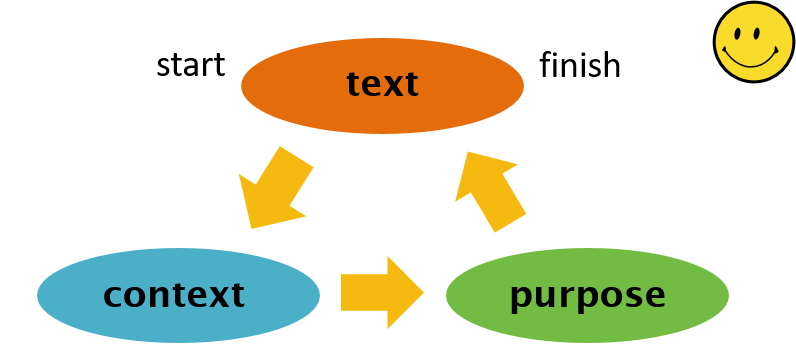
Interpretation involves a process of working out what legislation means. It’s not intuition, it’s not revelation, and it’s not working back from some desirable outcome. The basic process under our ‘modern approach’ is directed by the High Court1. Start with the text, consider context up-front in the ‘widest sense’2, choose between open meanings firstly by reference to purpose, and finish by returning to the text – text > context > purpose > text. This Circle of Meaning may be no guarantee of perfect answers. What it provides, however, is a practical framework within which to perform the task, and some assurance that the right things are considered in the right order and in the right way.

Text & context – Starting with the text is obvious3. Explore context at the same time – it’s not necessary first to find ambiguity. Work outwards from the words, passing from the Act into extrinsic materials, legislative history and beyond. Immediate context and legislative history are usually important. Don’t substitute what extrinsic materials may say for the law itself4. Ordinary meaning is a baseline, but literalistic approaches are out and dictionaries must be used with care5. Common law principles of interpretation are part of the context, as are interpretation statutes.
Context & purpose – Context is only useful to the extent it assists the ascertainment of meaning. The further you travel out into the land of context, the less likely what you find will be relevant or helpful in determining what your provision means. If context reveals more than one possible meaning, the ‘unqualified statutory instruction’ is to choose between them on the basis of purpose6. Where purpose cannot be reliably identified at the correct level7, competing merits are to be assessed. Here, fairness and policy are surer guides than logic and tight linguistics.
Objectivity & coherence – Two principles are particularly important. First, interpretation is an objective exercise from every angle. We don’t look for what parliament meant to say, but what it is taken to have meant by the words it used8. Objective discernment of purpose is ‘integral’ to the process9, and is assessed without preconception10. Legislative intention is essentially an output of the process – that is, what is attributed to parliament after the work has been done11. Second, the coherence principle requires us to seek harmony between clunky provisions and within the statute as a whole12. The law needs to work, and legislation is not to be ‘reduced to incoherence’13.
Process & text – Interpretation involves a process for applying settled principles to find out what a statute means. You may move around the Circle of Meaning several times, sometimes back and forth between the elements, to check the fit of what you find14. In every situation, however, interpretation requires anchoring your answer, finally and decisively, in the text of the statute15. We do this at least to ensure the meaning chosen is open on the words, but also for broad constitutional reasons. This final act of reconnection with the text is an important reality check.
This episode is best viewed in the official PDF format.
Credits – Gordon Brysland (photo above), Oliver, Claudia, Eric & several others.
Footnotes:
1 A2 [2019] HCA 35 (at [32]), cf Brysland (2020) 18 eJTR 193 (at [6.15]), Barnes (ed) Ch 8.
2 CIC Insurance (1997) 187 CLR 384 (at 408), BMW [2019] HCA 45 (at [43]).
3 Alcan [2009] HCA 41 (at [47]), Mondelez [2020] HCA 29 (at [14]).
4 Bolton (1987) 162 CLR 514 (at 518), Saeed [2010] HCA 23 (at [32]), Mondelez (at [70]).
5 A2 (at [32]); HHC [2017] NSWCA 188 (at [76-83]), Pearce 9th ed (at [3.33-3.35]) resp.
6 s 15AA Acts Interpretation Act 1901, SZTAL [2017] HCA 34 (at [39]), (2018) 92 ALJ 81.
7 Carr [2007] HCA 47 (at [5-7]), Mammoet [2013] HCA 36 (at [40-41]), Episode 43 (at [4]).
8 Black-Clawson [1975] AC 591 (at 613), Momcilovic [2011] HCA 34 (at [441]).
9 Calidad [2020] HCA 41 (at [91]), A2 (at [124]), Yeo [2020] FCAFC 199 (at [27]).
10 cf AEU [2012] HCA 3 (at [28]), Deal [2016] HCA 31 (at [37]).
11 Lacey [2011] HCA 10 (at [43]), Zheng [2009] HCA 52 (at [28]), Episode 46.
12 Project Blue Sky [1998] HCA 28 (at [70]), Universal [2020] NSWCA 106 (at [12]).
13 IBBACC [2016] HCA 8 (at [76]), SAS [2018] HCA 55 (at [20]), S4 [2014] HCA 34 (at [42]).
14 cf Thomas [2008] NSWCA 316 (at [22]), Glazebrook in Bigwood (ed) (at 169-176).
15 CMH [2012] HCA 55 (at [39]), Thiess (at [22]), BFW20 [2020] FCAFC 121 (at [111]).
